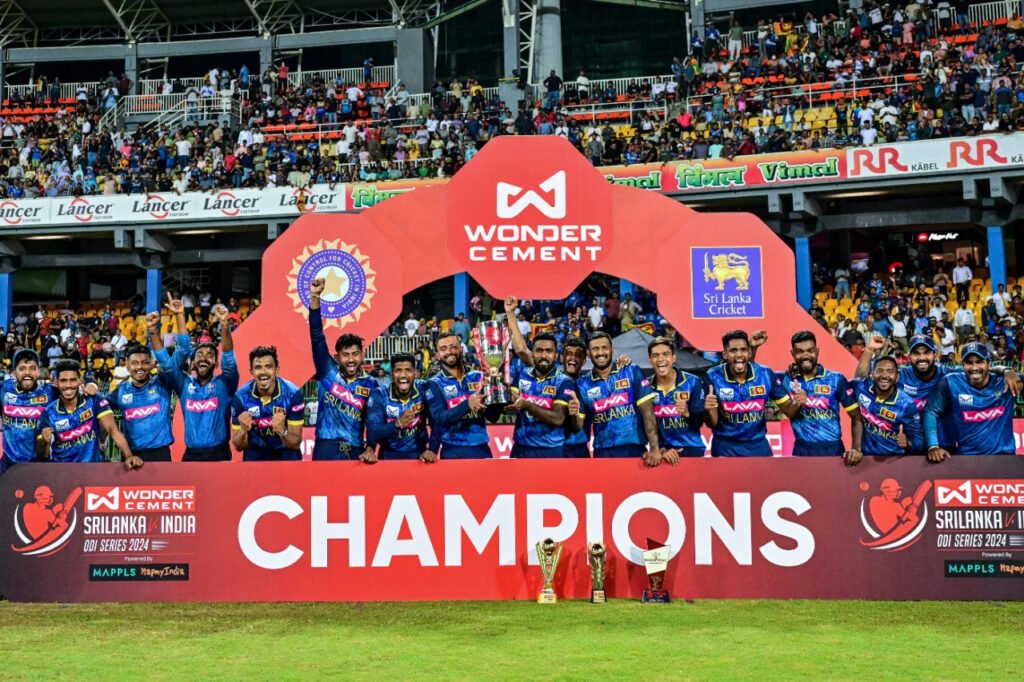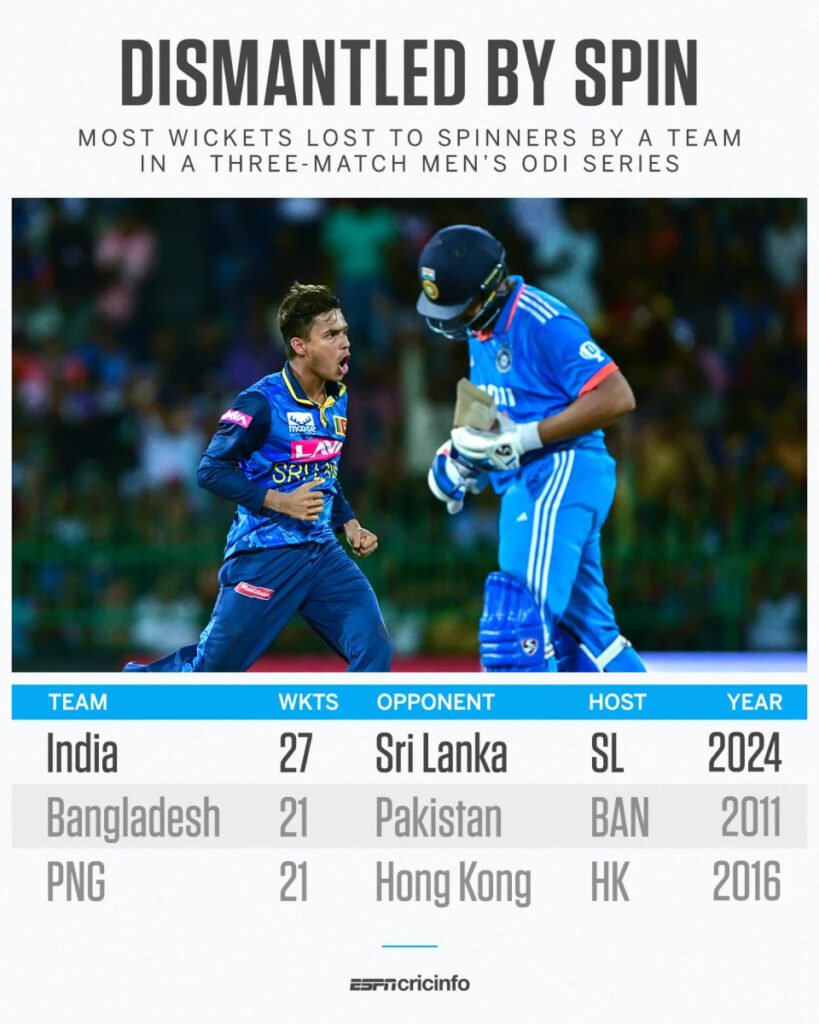Sri Lanka vs India 3rd ODI Updates: Sri Lanka won their first bilateral ODI series against India in 27 years with a historic victory against India in the third ODI in Colombo, winning by 110 runs.
Dunith Wellalage stole the show with a career-best 5 for 27 total, helping Sri Lanka secure a remarkable victory.

Key Performances and Match Results
India 138 (Rohit 35, Wellalage 5-27) lost to Sri Lanka 248 for 7 (Avishka 96, Mendis 59, Parag 3-54) by 110 runs.
Sri Lanka won the third and last ODI bilateral series against India in 27 years thanks to a commanding 110-run victory from Avishka Fernando, who scored the highest individual score of the series with 96, and to a five-for from Dunith Wellalage.
India’s struggles against spin over the past week came to a head as they lost nine wickets to spinners for the third game in a row, matching their highest total of 27 wickets lost across a three-match series.
This time around, Wellalage led the destroyers with five for twenty-seven, but throughout the series, it has alternated between Wanindu Hasaranga, Jeffrey Vandersay, and even Charith Asalanka. But India has never looked like they could consistently compete, save perhaps during Rohit Sharma’s now-expected top-order romps.
But this time, Wellalage caught Rohit trying to sweep before he could significantly reduce Sri Lanka’s score, thus even Rohit’s contribution was reduced to a short cameo (35 off 20).
Other than him, only three players reached double digits: Washington Sundar (20, 15, 30), Riyan Parag (20, 15), and Virat Kohli (20). Of those, only Washington’s innings attempted to reimpose any kind of pressure on the Lankan bowlers.
Avishka’s 96 off 102 earlier in the day had put Sri Lanka up so nicely that not even a collapse that saw them lose 28 runs for five wickets could derail their innings to any meaningful end; yet, India’s difficulties placed an even greater premium on that performance.
Throughout his innings, he shared in two of Sri Lanka’s most lucrative partnerships—89 and 82 for the first and second wickets, respectively. However, his innings did not demonstrate Sri Lanka’s superior spin game; rather, it demonstrated the team’s ability to take advantage of the seamers’ opportunities.
In this instance, Mohammed Siraj was dismissed for his joint-worst ODI stats of 78 for 1 off nine overs, while Shivam Dube managed just nine runs off his four overs. And 36 of those 78, or a strike rate of 200, were attributable to Avishka.
However, Siraj’s mistakes in lines and lengths were more to blame for this than anything Avishka did to turn him down. However, these are the margins that need to be taken advantage of on uneven terrain like those found at Khettarama.
Siraj was also guilty of bowling too straight to him; of the 36 runs he gave up to Avishka, 32 were square or behind square on the onside. Anything short was always put away.

However, Parag was making a memorable debut, while Siraj was having a rough time. With a leg break that slid over his front pad and another that gripped, straightened, and skidded to trap Charith Asalanka on the crease, he took the crucial wicket of Avishka.
But the ballplayer who posed the most threat, Wellalage, was struck out by a delivery that dipped and turned, pitched middle and spun past the outside edge to knock back off stump.
While some late blows affected his economy rate of six an over, the other three spinners, Axar Patel, Kuldeep Yadav, and Washington, were as economical as ever, taking one wicket each and none going for more than Axar’s 4.10 per over.
Though Sri Lanka put together two solid stands at the top of the order, Parag and his spin allies would have to wait patiently for their rewards. In addition to Avishka, Pathum Nissanka (45) and Kusal Mendis (59) contributed significantly, but Sri Lanka’s middle order collapsed quickly and unexpectedly, much like in the previous two matches.
They stammered from 171 for 1 to 199 for 6. They managed to score just 49 runs in the 36 overs that they lost Avishka in, and from midway through the 48 overs, or 72 deliveries, they managed to score no boundaries at all. Moreover, they were suddenly having difficulty hitting 250 after previously aiming for a score of about 280.
Luckily for them, Mendis, one of Sri Lanka’s top spinners, was available at the finish and he could deliver some potent hits to help drive the score closer to 240. Considering the strong start given by Avishka and company, the score appeared competitive but ultimately proved sufficient.
Rohit Sharma Highlights India’s Batting Issues Against Spin Following Series Loss
Following their 2-0 ODI series loss to Sri Lanka, India’s skipper Rohit Sharma has acknowledged the necessity for a strategic reassessment, stressing the significance of tackling their issues with spin.
“A series loss doesn’t mean the end of the world,” the skipper continued. For the past several years, these players have been playing excellent cricket.”
“We need to talk about it.” When asked if their lack of effort was the reason they lost the ODI series 2-0 against Sri Lanka on dry Colombo wickets, India skipper Rohit Sharma responded in like way. In a three-match series, India lost more wickets to spin than any other team—27, to be exact.
“We need to talk about it.” When asked if their lack of effort was the reason they lost the ODI series 2-0 against Sri Lanka on dry Colombo wickets, India skipper Rohit Sharma responded in like way. In a three-match series, India lost more wickets to spin than any other team—27, to be exact.

“We need to talk about it.” When asked if their lack of effort was the reason they lost the ODI series 2-0 against Sri Lanka on dry Colombo wickets, India skipper Rohit Sharma responded in like way. In a three-match series, India lost more wickets to spin than any other team—27, to be exact.
“I don’t think it’s a concern,” Rohit declared following India’s first defeat in an ODI series against Sri Lanka since 1997. “But it’s something we should really consider incorporating into each of our personal game plans. Over the course of the series, we were undoubtedly under pressure. We must investigate it, take alternative action, have a conversation about it, and return with new ideas.”
With two half-centuries, Rohit was unquestionably India’s finest batsman during the series. Every run-chase he led had a barnstorming start thanks to him, but as the field expanded and the ball became older and started to take turns, batters found it harder to maintain a constant pace. especially those that are fresh. The middle class in India was unable to overcome this obstacle.
In the first match of the series, India lost 5 for 57 after leading 231 to 75 without losing. They fell apart on Sunday, going from 97 for 0 to 147 for 6 in a 241 chase. Before they lost 6 for 45 on Wednesday, Rohit blasted 31 of the 37 runs for the first wicket.
Was India growing smug? “It’s a joke,” Rohit answered back. As long as I am leading the team here, there is no room for complacency when you play for India. That will not come to pass. We were indeed outplayed, but you still come here aiming to win every game, give it your all, and look for solutions. It’s important to give credit where credit is needed; Sri Lanka outperformed us in cricket.”
India had to chase after losing all three of their tosses. The amount of turn available under lights made batting increasingly difficult in every game. With the series at stake on Wednesday, India bolstered their batting lineup by selecting Riyan Parag in lieu of Arshdeep Singh, their second fast bowler.
Shivam Dube and Mohammed Siraj had to share the fresh ball as a result. According to Rohit, the conditions played a major role in the bowling change, but it was also partially due to the necessity of giving some of the younger guys some playing time. With a 3 for 54 on his ODI debut, Parag—who dazzled in the T20I leg of the tour with his variety of legspin and offspin—was the best bowler for India.
“We looked at the conditions and thought taking pace off is an ideal combination,” Rohit stated. That being said, there are a lot of guys who are waiting in the wings for us. We need to examine a few of the men who haven’t been given a chance. Overall, we performed poorly as a cricket team over the series, which is why we are in this position.”
Existed any advantages? “Some, like the way our bowlers bowled,” Rohit remarked. “However, even if you want to focus on the positives, I think there are many more areas we should be looking at as well. We’ll return and discuss what to do in similar situations in the future.”
India’s next major international tournament, the Champions Trophy in 2025, won’t take place until after their January ODI series against England. In addition, they have a protracted gap before playing any international matches until late September, when a series against Bangladesh marks the start of the home Test season.
“A series loss doesn’t mean the end of the world,” Rohit stated. “Over the past few years, these players have been playing excellent cricket. Yes, from time to time we will lose a single series; but, what matters most is how we recover and move on.”





